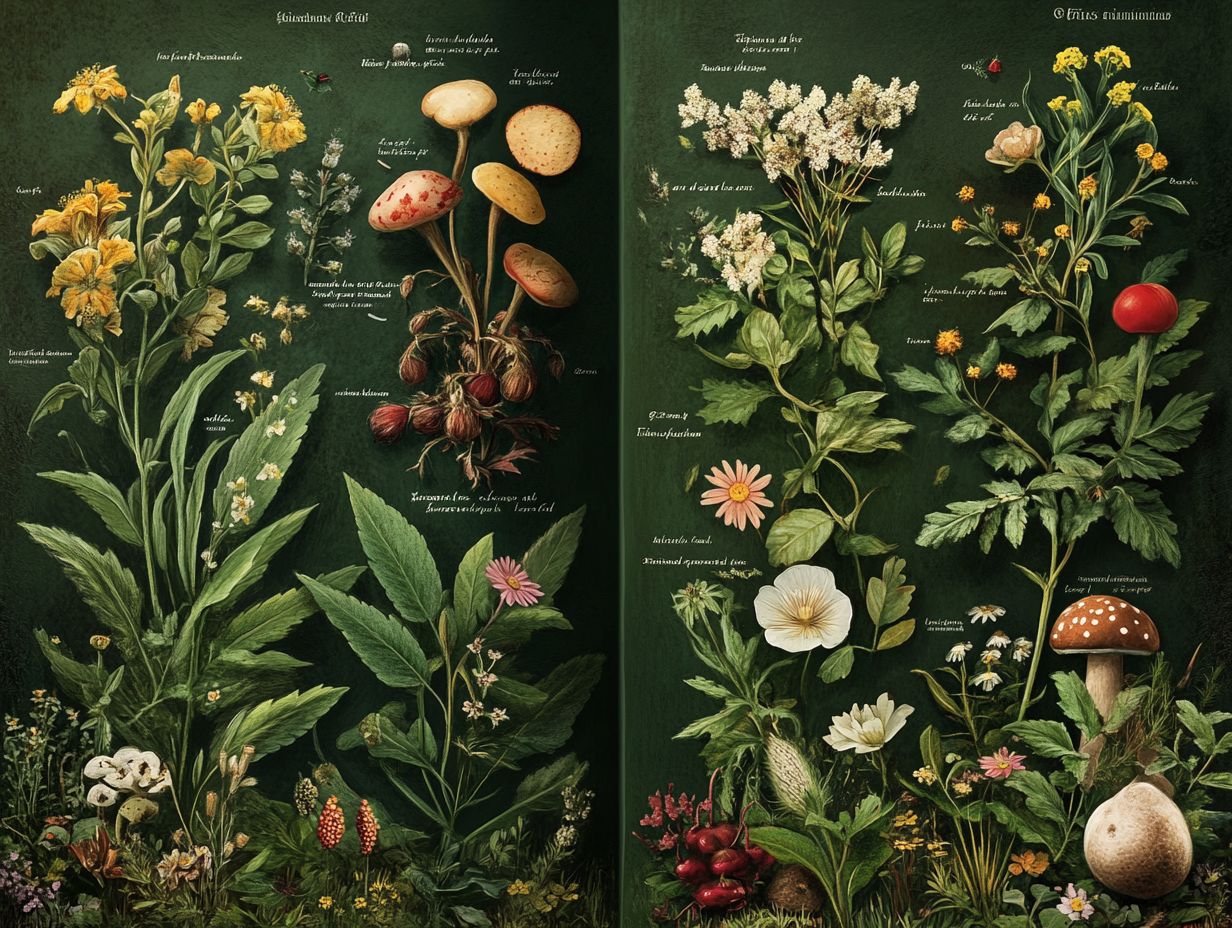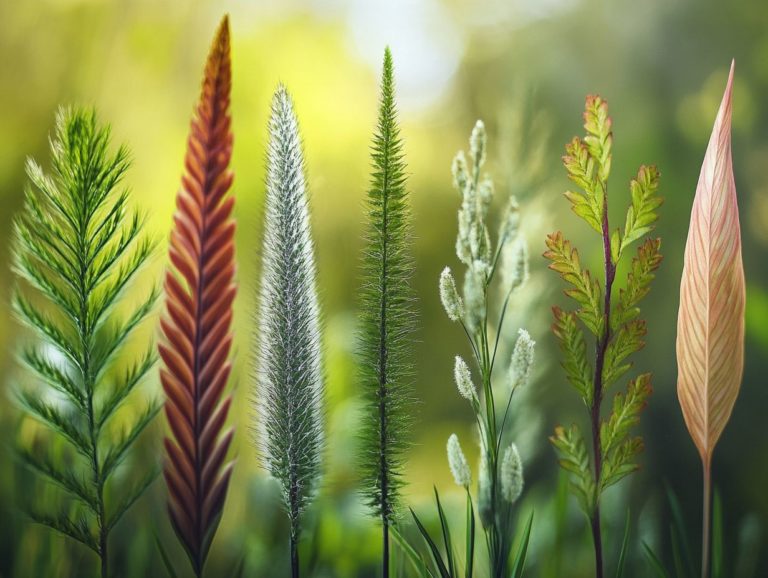How to Distinguish Edible from Poisonous Plants
Navigating the world of plants can be an exhilarating yet perilous journey. Knowing the difference between which plants nourish and which can pose a threat can save your life.
This article outlines the fundamental differences between common poisonous plants and their edible counterparts. From identification tips and distinctive characteristics to safe foraging practices, you ll find essential precautions and guidance.
Arm yourself with knowledge so you can explore the wonders of nature with confidence and safety.
Contents
- Key Takeaways:
- Understanding the Differences
- Common Poisonous Plants
- Identifying Edible Plants
- Precautions to Take
- What to Do in Case of Poisoning
- Frequently Asked Questions
- How can I identify edible plants from poisonous ones?
- What are some common features of poisonous plants to watch out for?
- Are there any rules of thumb for identifying edible plants?
- What are some reliable sources for learning about edible plants?
- How can I stay safe while foraging for wild plants?
- What should I do if I accidentally consume a poisonous plant?
Key Takeaways:

- Always research and familiarize yourself with the characteristics of common poisonous and edible plants to avoid accidental consumption.
- When foraging for edible plants, follow safety tips such as identifying the plant correctly and avoiding areas with potential contamination.
- If you suspect poisoning, seek medical help right away don t wait!
Understanding the Differences
Knowing the difference between edible and poisonous plants is essential for anyone passionate about organic gardening. Learning how to spot edible plants in the wild fosters environmental awareness.
By mastering the identification of various plant characteristics, you can significantly elevate your gardening skills. It ensures safety during foraging and nurtures the broader ecosystem by promoting responsible interactions with plants.
Common Poisonous Plants
Common poisonous plants can present serious health risks to both humans and animals. Individuals in Boston, Massachusetts, and beyond may come across these plants in their gardens or during wilderness survival activities.
Recognizing the distinctive features of poisonous plants helps you avoid stomach problems and other severe health consequences linked to contact poisoning.
Identification and Characteristics
Identifying plants is crucial when distinguishing between edible landscapes and potentially harmful species. To navigate the risks associated with poisonous plants, it’s important to understand what is the difference between edible and poisonous plants and cultivate sharp plant identification skills.
Pay close attention to physical traits and environmental factors. This knowledge enhances your environmental awareness and encourages safer interactions with nature, especially in urban areas like Boston, Massachusetts.
Consider that leaf shape varies significantly among species; this variation can indicate a plant’s edibility. The vibrant colors and patterns of flowers not only draw in pollinators but also serve as clues to the plant’s identity.
By recognizing the preferred habitats of specific plants whether they flourish in wet, shady, or open areas you can further refine your ability to navigate your surroundings confidently. Being aware of poisonous varieties is vital for anyone exploring the wilderness.
This underscores the importance of education in developing a well-rounded understanding of local flora.
Identifying Edible Plants

Identifying edible plants is a vital skill for anyone immersed in organic gardening or exploring the art of foraging. Learning how to identify edible vs. poisonous fungi is key to avoiding dietary mishaps.
With insights from experts like Ben Barkan of HomeHarvest LLC, you can cultivate a profound awareness of plants. This enables you to confidently identify and incorporate edible varieties into your culinary pursuits.
Ready to explore nature? Start your foraging journey today with these tips!
Tips for Safe Foraging
Safe foraging demands a blend of knowledge, skill, and respect for the natural world. Distinguishing between edible and poisonous plants is crucial. By applying effective safety measures and grasping the principles of plant testing, you can significantly reduce the risks associated with foraging in both wilderness settings and urban gardens. Acquiring these essential survival skills enhances your ability to thrive in various environments.
To get started, familiarize yourself with the local flora. Learn to recognize key characteristics of edible plants, such as leaf shape, flower color, and growth patterns. It’s wise to carry a reliable field guide or download an app dedicated to plant identification.
Before indulging in any new discovery, make sure to perform the Universal Edibility Test . Sample a small amount and wait several hours to monitor for any adverse reactions. Pay attention to environmental factors, like pollution in urban areas or potential toxins in certain habitats, to ensure safe foraging practices.
Mastering these techniques shields you from common pitfalls and significantly enhances your confidence and resourcefulness in the great outdoors.
Precautions to Take
Taking precautions when interacting with plants is crucial for your safety. This is especially true when distinguishing between edible and poisonous varieties. By engaging in practices like plant testing and learning how to identify edible plants in the wild, you can greatly minimize the risk of contact poisoning or stomach problems.
For anyone in Boston, Massachusetts, and beyond, implementing effective plant safety measures can turn your outdoor adventures into thrilling experiences! You will gain nothing but fond memories.
How to Protect Yourself from Poisonous Plants
Protecting yourself from poisonous plants requires a proactive mindset. Understanding their characteristics and adhering to effective safety measures should become second nature. You can significantly diminish the risk of accidental exposure to toxins by taking these steps:
- Don protective clothing
- Use gloves when handling unfamiliar plants
- Remain vigilant while foraging
Educating yourself about emergency precautions is essential. Recognizing the symptoms of poisoning will enhance your safety during outdoor adventures.
Familiarizing yourself with common poisonous plants in your area is essential. Knowledge truly is your best defense! To enhance your understanding, check out resources like how to identify common wild edibles. Consider keeping a guidebook or using a plant identification app to swiftly recognize harmful species.
When exploring wild areas, sticking to well-trodden paths can further minimize your contact with potential threats. If you suspect exposure, having a basic first aid kit at your disposal is invaluable. Keep the local poison control center’s contact information handy.
If you ever feel uncertain about the safety of a plant, it s always wise to abstain from touching or consuming it. Your well-being is worth the extra caution.
What to Do in Case of Poisoning

In the unfortunate event of poisoning from plant exposure, understanding the appropriate steps to take is crucial for effective treatment and recovery. Immediate action typically involves rinsing the affected area. Long-term care may necessitate medical intervention, including reaching out to poison control.
By familiarizing yourself with the symptoms associated with plant toxins, you ll be able to respond swiftly and efficiently. This ultimately ensures better outcomes during emergencies.
- Nausea
- Vomiting
- Skin irritation
Stay informed and be prepared. You have the power to stay safe and enjoy your foraging journey!
Immediate and Long-Term Treatment
Immediate and long-term treatment following poisoning from toxic plants is crucial for minimizing health risks and ensuring your full recovery. Start by rinsing your mouth and skin thoroughly, and then promptly seek medical help based on the severity of your symptoms. Effective communication with poison control will provide you with essential guidance on the next steps, including the possibility of hospital admission for long-term care.
If you have mild exposure, manage your care at home. However, if you experience persistent or severe symptoms, act fast and seek medical help right away!
Healthcare professionals will assess the specific toxin involved and may administer activated charcoal, a substance used to help absorb toxins in the stomach, to limit absorption in your digestive system. Monitoring your vital signs and providing supportive care such as IV fluids or medications to alleviate symptoms is vital.
Long-term risks can include organ damage or ongoing neurological issues, which highlights the importance of follow-up care. This comprehensive approach ensures that you not only receive immediate relief but also the necessary support for a safer recovery over time.
Frequently Asked Questions
How can I identify edible plants from poisonous ones?
To distinguish edible from poisonous plants, make sure to educate yourself on their specific characteristics and identifying features. This includes studying the plant’s physical appearance, smell, and habitat. For more detailed information, refer to resources on how to spot edible vs. poisonous plants. It’s also a good idea to seek guidance from a trained expert or reference guide before consuming any wild plants.
What are some common features of poisonous plants to watch out for?

Commonly observed features of poisonous plants include bright colors and smooth or shiny leaves. These plants may also have a bitter or unpleasant smell. Keep in mind that these characteristics can vary between different species, so always research a plant before eating it.
Are there any rules of thumb for identifying edible plants?
While it is not recommended to solely rely on rules of thumb, a few general guidelines can help in identifying edible plants. For example, plants with white or yellow flowers are often safe to eat, while those with red or purple berries are more likely to be poisonous. To ensure safety, refer to a comprehensive resource like how to forage edible plants safely.
What are some reliable sources for learning about edible plants?
One of the best ways to learn about edible plants is to attend a workshop or class led by a trained expert. You can also find reliable information through reputable books and online resources. Always cross-reference information from multiple sources to ensure accuracy.
How can I stay safe while foraging for wild plants?
Before consuming any wild plants, always positively identify them as edible and not poisonous. To help with this, refer to guides on how to identify safe wild edibles. It’s wise to wear protective gear, such as gloves, while handling unknown plants. If you’re unsure about a plant’s safety, it’s best to avoid it altogether. Stay safe and happy foraging!
What should I do if I accidentally consume a poisonous plant?
If you believe you have consumed a poisonous plant, act fast and seek medical help right away! Do not induce vomiting unless directed by a medical professional. It s also helpful to bring a sample or photo of the plant to aid in proper identification and treatment.






